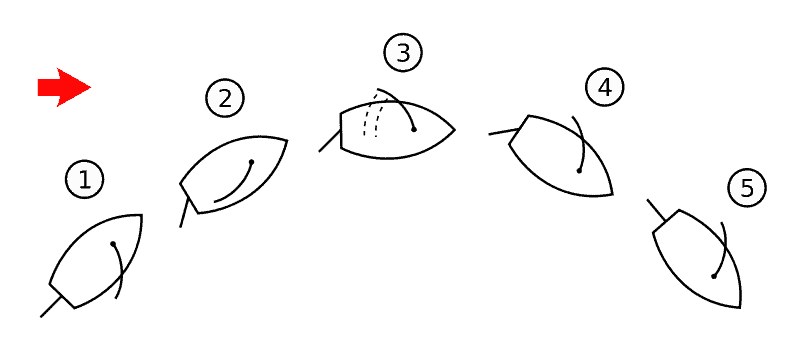Jibing is when you turn the boat away (bear away) from the wind and bring the stern across the wind. Unlike tacking where you turn toward the wind (head up) and bring the bow across the wind which luffs the sails and takes all the power out of them, when jibing, the sails are powered up through the entire maneuver and thus more care and control is required.
Catamarans generally have a three-point rigging system which means there is no back stay. This makes jibing a far more delicate maneuver on a catamaran than on monohulls which generally have a back stay and are thus far safer when jibing.
 preparing to jibe a catamaran
preparing to jibe a catamaran
- Centralize the traveler so that the main can be centralized
- Before starting the turn (bearing away) begin sheeting the main sheet in so that as you bear away the main is centralized, be sure that the main is sheeted in hard before the jibe.
- The reason for sheeting the main in hard is twofold, when the main is back winded and slams over to the opposite tack the travel of the boom and sail is reduced to a minimum reducing the shock load to the rig, secondly, when the main is sheeted in hard it acts like a back stay supporting the rig from the impact of the jibe from the rear in the absence of a backstay.
- Once the main has back winded and changed sides so that you are on the opposite tack, start to head up and at the same time release the main as fast as possible, this will ensure that you keep the power on as you go through the second part of the jibe.
- Once the jib has back winded, release the windward jib sheet while tightening the leeward one until the jib has passed through the fore triangle and can be trimmed by the leeward sheet and the windward sheet can be released completely.
- When jibing the jib always be careful to make sure it backwinds first and then control it so that it does not fly forward of the forestay. If you let it fly too early and it flies free forward of the forestay then you will have to use the leeward sheet to pull it all the way back around the forestay which is not good for the sail or the nerves.
Sail With Us to Learn


Week-Long Liveaboard Courses
Rare RYA Classes & Certifications
Catamaran Guru’s real-life practical methods combined with up-to-date sailing theory in lessons aboard recent model catamarans…or your own boat!
Prepare for certifications or take the first step aboard to embark on your dream life of boat ownership or cruising
Classes in S Florida and the Bahamas.

Estelle Cockcroft
Catamaran Guru Co-Founder
Estelle Cockcroft is a seasoned sailor, catamaran expert, and co-founder of Catamaran Guru. With over 70,000 NM sailed and 30+ years aboard, she empowers new cruisers with expert advice on liveaboard life, yacht ownership, and ocean adventures.




